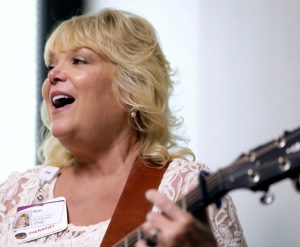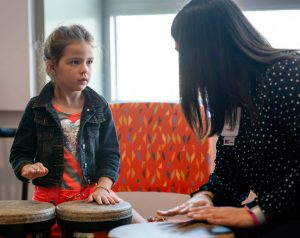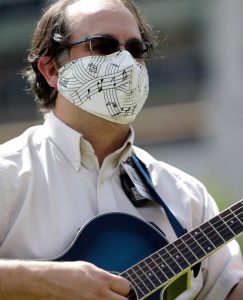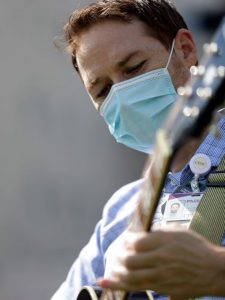Ann Jackovich was working recently with a patient at UPMC McKeesport who was diagnosed with schizophrenia; her condition had her pacing, fidgeting, acting out. There was one tool in Ann’s therapeutic toolkit that was particularly effective in the moment: Beyoncé.

Ann Jackovich, UPMC McKeesport music therapist
Jackovich is a music therapist — part of UPMC’s Creative and Expressive Arts Therapy program (CEAT). She finds innovative ways to meet patients where they are. With this particular patient, Beyoncé is a pathway to a healing experience.
“For those moments, the patient is in reality with me,” Jackovich says. “When the song is over, I’m able to engage in conversation for about 10 minutes, and she’s calm, she’s grounded. The music grounds her into reality. It’s a great tool.”
Music therapy is applicable in nearly every clinical setting, and at UPMC, it’s used primarily in adult behavioral health and general pediatric patients. Music therapy applications run the gamut, from helping adults overcoming a substance use disorder to write and sing about their addictions and goals to exposing infants in the NICU to music to help regulate their heart rates.
Finding Their Calling
Combining natural musical talent with a career helping others is common among UPMC’s music therapists. Some, like Nicole Steele, a creative and expressive arts therapist at UPMC Children’s Hospital of Pittsburgh, considered pursuing a degree in performance before finding their true passion.

Nicole Steele plays drums with a young patient.
Steele is one of three music therapists at UPMC Children’s, where the Creative and Expressive Arts Therapy unit works closely with the Child Life team to work with patients of all ages and diagnoses.
“Our patients are here for medical reasons, and we’re an ancillary service supporting that,” says Kory Antonacci, CEAT program coordinator and one of UPMC Children’s certified music therapists.
Antonacci, Steele and Brittany Stone, the team’s other music therapist, are preparing to publish research they conducted about rhythmic entrainment in the NICU at UPMC. Since infants can’t respond verbally to music, they rely on physiological feedback to show how their work is affecting patients.
“We implement our music and the tempo to try to maintain their vital signs within normal levels,” Antonacci explains. “Neonates tend to run a very high heart rate, so we want to be able to relax them without having to add another medication, and we also want to keep their oxygen saturation up.”
Music therapy at the hospital can involve patients directly or incorporate their loved ones. It can mean playing music on a tablet to keep a child engaged during a procedure or helping an adolescent patient work out feelings in words, then turning them into a track using a beat-making app.
It can also involve helping patients and their families deal with the difficult moments.
“We will often be called for withdrawal of care,” Antonacci explains. “Having a therapist in the room in those moments is key. And we hear all kinds of beeps, the morphine drips, nurses providing care, doing their job — as we begin to remove support, those sounds start to decrease, and music provides a container in that moment, where people can express their emotions. You can only imagine what that moment feels like.”
“The bottom line is: We can find a way to go into any room in this 330-bed hospital and meet the medical, social, emotional, physical needs of that patient,” Antonacci says. “And that’s pretty cool.”

Robert Miller, CEAT program coordinator, UPMC Western Psychiatric
Beats for Behavioral Health
Robert Miller, CEAT program coordinator, oversees the CEAT department at UPMC Western Psychiatric Hospital and coordinates UPMC’s music therapy internship program. He and music therapist Phillip Mauskapf comprise the full-time music therapy staff at UPMC Western Psychiatric.
Miller and Mauskapf tailor their sessions to the clinical focus of each unit they visit.
“The nice thing about music therapy is that we can adapt to the specific needs of the unit,” Miller says. “Having a group of adolescents with intellectual disabilities is very different from adults with eating disorders, so we adapt to use the music to fit their needs.”
Adjusting in a Difficult Time
COVID-19 has forced some extra creativity among UPMC’s music therapists. Last year, UPMC Children’s dedicated the Nora Grace Kaufman Center for Creative Arts Therapy and Dream Big Studio, two innovative spaces for collaborative creative work. However, the restrictions put in place to keep patients and staff safe have forced a return to the roots of the music therapists’ work.
“It brought me back to the basics,” Antonacci explains. “Me with a guitar in a child’s room.”

Phillip Mauskapf, UPMC Western Psychiatric music therapist
At UPMC McKeesport, Jackovich has moved live performances that previously took place on-site for her addiction medicine patients to a streaming platform with the help of the Sonny Pugar Memorial Inc. Music Smiles program and the McKeesport Hospital Foundation.
At UPMC Western Psychiatric, one of Mauskapf’s ongoing specialty projects, a mobile recording studio, is currently on hold due to COVID-19. Now, because of safety precautions, he’s turned the sessions into a creative writing group. He uses this method with the general adolescent and bipolar disorder units, helping patients express what is troubling them through writing songs about any topic.
“Along the way, the patient’s major needs pop up while working on songs. Whenever this happens, we talk about how to develop skills to overcome those problems. It could be learning your words have value, knowing you don’t have to be perfect, or anything in between — it all comes out during the songwriting process,” Mauskapf says.
Everyone Has a Song
Across the board, the music therapists agree that this foundational relationship with music helps make music therapy sessions successful.
“People respond to music,” Mauskapf says. “It’s a universal area where everyone can be moved. It impacts people much deeper than we realize. When we take the time to understand, it makes a very accessible form of helping ourselves and others.”








